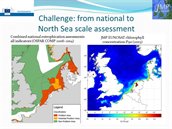Challenge

The abundance of algae in marine waters is an important aspect of water quality, especially in estuaries and coastal waters. Excessive growth of algae caused by human activities (eutrophication) can disturb food webs and induce loss of underwater vegetation and oxygen depletion near the seafloor. Chlorophyll is the main photosynthetic pigment in algae and a proxy for algal biomass. Current monitoring efforts primarily consist of taking water samples from ships and analyzing these in a laboratory. The abundance of algae varies strongly in time and space and is difficult to capture through costly ship-based sampling.
North Sea countries, although following international guidelines, use different methods to determine chlorophyll-a concentrations and to assess eutrophication. Comparability between countries is a strong wish in OSPAR (Convention for the Protection of the Marine Environment of the North-East Atlantic) and a requirement under the EU Marine Strategy Framework Directive.
The EU project JMP EUNOSAT includes three Activities:
1. Proposal for a coherent set of assessment levels for eutrophication in the North Sea
Assessment levels are based on historic reference concentrations of chlorophyll. To estimate these reference concentrations we use models, ship-based time series and satellite data in a step-wise approach. The project also develops new assessment areas based on growing conditions for algae. The outcomes are compared with current assessments of eutrophication in OSPAR.
2. Quality controlled satellite images of chlorophyll for the entire North Sea
The project evaluates existing publicly accessible satellite-based chlorophyll products using ship-based monitoring data. Satellite data providers are Copernicus Marine Environment Monitoring Services, European Space Agency and other institutes, e.g. Ifremer. We use these results to determine the chlorophyll products for different water types in terms of chlorophyll, suspended matter and coloured dissolved organic matter concentrations. The quality controlled chlorophyll products are then merged together into a coherent chlorophyll product. This contributes to the development of new assessment areas.
3. Proposal for North Sea wide operational collaboration
The project investigates how North Sea countries can continue to cooperate after the project has ended. We develop several options for collaboration. We also develop methods to compare in-situ monitoring data from North Sea countries, that use different sampling schemes and analytical techniques, and to integrate chlorophyll data from different sources (i.e. national surveys, ships of opportunity and remote sensing).
> back to JMP EUNOSAT homepage